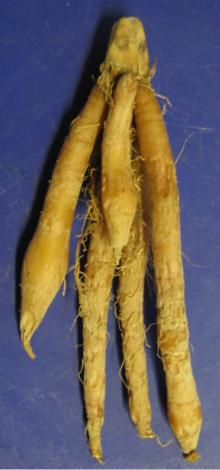
Back Boesenbergia rotunda AST Temu kunci BAN Boesenbergia rotunda CEB Chinesischer Ingwer German Ĉina zingibro Esperanto Boesenbergia rotunda Spanish زنجبیل چینی Persian Boesenbergia rotunda French Ujjgyökér Hungarian Temu kunci ID
This article includes a list of general references, but it lacks sufficient corresponding inline citations. (March 2013) |
| Boesenbergia rotunda | |
|---|---|

| |
| Scientific classification | |
| Kingdom: | Plantae |
| Clade: | Tracheophytes |
| Clade: | Angiosperms |
| Clade: | Monocots |
| Clade: | Commelinids |
| Order: | Zingiberales |
| Family: | Zingiberaceae |
| Genus: | Boesenbergia |
| Species: | B. rotunda
|
| Binomial name | |
| Boesenbergia rotunda | |
| Synonyms[1] | |
| |
Boesenbergia rotunda (Thai: กระชาย, romanized: krachai, Khmer: ខ្ជាយ, romanized: k'jeay, Indonesian: temu kunci, Burmese: ဆိတ္ဖူး, romanized: Hsei' Hpu), commonly known as Chinese keys,[2] fingerroot, lesser galangal or Chinese ginger, is a medicinal and culinary herb from China and Southeast Asia. In English, the root has traditionally been called fingerroot, because the shape of the rhizome resembles that of fingers growing out of a center piece.
Fingerroot is a kind of ginger (Zingiberaceae). It is an annual crop and indigenous to southern Yunnan Province, China, to west Malaysia, growing in tropical rain forest.[3] It has an underground stem, known as a rhizome. This spreads into many bunches in the same way as banana, ginger, galangal and turmeric. These structures accumulate nutrients and the middle part is more swollen than the head and bottom part. The inner part has a range of colours and aromas depending on the variety of fingerroot. The above-ground part is composed of a leaf stalk that has a sheath covering it. The leaf sheaths are red, the blades are oval in shape and the apex of leaves are sharp.[4] Chinese ginger is a herbaceous plant with a height of 61–91 centimetres (2–3 ft). The leaf is about 50 cm (20 in) long and 12 cm (4.7 in) wide.[3] The middle of the petioles are deeply grooved. The flower appears between the leaf sheaths at the bottom of the trunk. The petals are white or light pink. Flowers bloom one at a time.[4]


- ^ "Boesenbergia rotunda (L.) Mansf". World Flora Online. Retrieved 17 June 2024.
- ^ "Boesenbergia rotunda". Germplasm Resources Information Network. Agricultural Research Service, United States Department of Agriculture. Retrieved 12 December 2017.
- ^ a b "Boesenbergia rotunda (L.) Mansf". Plants of the World Online. Royal Botanic Gardens, Kew. Retrieved 15 October 2017.
- ^ a b กระชาย สมุนไพรลดน้ำหนัก ชะลอความชรา บำรุงร่างกายให้ฟิตปั๋ง [Krachai, a weight loss herb, delays aging, and nourishes the body to be fit.]. kapook.com. 2015-07-21. Retrieved 15 October 2017.